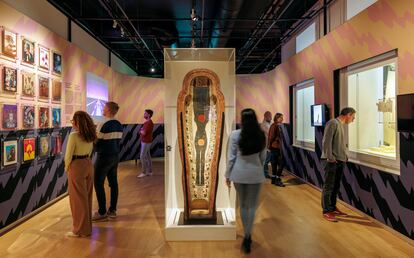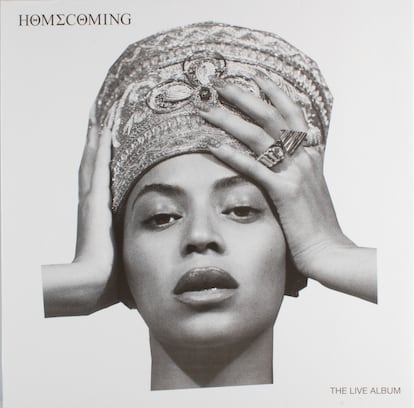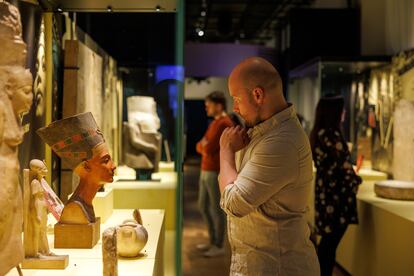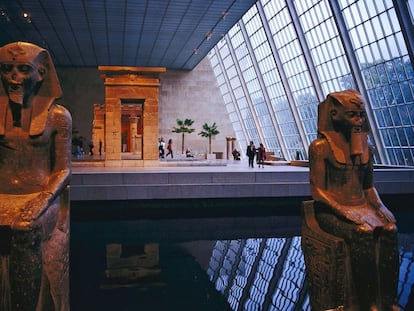Dutch Museum of Antiquities banned from further excavation of Egyptian necropolis for showing Beyoncé and Rihanna as Queen Nefertiti
The museum shows the influence of ancient Egypt and Nubia on musicians from the African diaspora, but Egyptian authorities consider it Afrocentric and accuse the institution of falsifying history


Egyptian authorities have accused the Dutch National Museum of Antiquities in Leiden of falsifying history in its exhibition on the influence of Ancient Egypt on the music of the African diaspora. The exhibition shows Black artists embodying Egypt’s past rulers and is not based on the museum’s own creations, but on album covers and other cultural artifacts previously created by artists such as Beyoncé and Rihanna, who were inspired by Queen Nefertiti for several of their creations. Also on display is a music video in which actor Eddie Murphy portrays Pharaoh Ramses II, and a sculpture of rapper Nas as Tutankhamun. According to the Egyptian Antiquities Service, it is an Afrocentric approach and a case of cultural appropriation. As a result, it has banned the museum from further excavation at the Saqqara necropolis near Cairo.
Entitled Kemet, Egypt in hip-hop, jazz, soul & funk, the exhibition was already the subject of criticism on social media in April — some of it racist in nature — shortly after its opening. Now, they have received a message from the Egyptian Antiquities Service prohibiting them from continuing work on excavations at Saqqara, one of the largest royal necropolises in the world. The Dutch experts work with other international colleagues and, in view of this situation, have asked their partners at the Egyptian Museum in Turin to take over their concession.
The controversy is similar to the one that arose in April over the casting of a Black actress, Adele James, to play Queen Cleopatra in a Netflix docudrama. The idea of the legendary sovereign’s alleged African roots triggered a signature campaign, as well as a complaint that was filed with the Public Prosecutor’s Office and discussions in the Egyptian Parliament. In 2018, Beyoncé was criticized by Egyptian authorities for dressing up as Nefertiti at the Coachella festival in the United States.

The prohibition on returning to Saqqara seems regrettable to Wim Weijland, director of the Dutch museum, but his team has no plans to alter the display. “We received that letter and no one has come from Egypt to visit us. We have explained the content of our work in a letter, without getting a response, for now,” he said. The aim of the exhibition, Weijland explained, is to show “the artists’ fascination with Kemet, which refers to the fertile black earth left by the rising Nile and is used to denote Ancient Egypt.” “It’s a dialogue between decades of musical history and Egyptian antiquity,” he added.
According to Weijland, they have tried to reflect the way black artists who grew up in the United States, Jamaica and the Netherlands interpret Kemet in their creations. “We use this term, but also ‘Egypt’ or ‘Ancient Egypt.’ Kemet translates as black, although it ranges from dark red to deep black, and some musicians prefer it to the name of Egypt. It is a source of inspiration in the music of the African diaspora.” Curator Daniel Soliman has told Dutch media that the Egyptian reaction may be due to two reasons: “The repressed nationalism and the racism against Blacks in that country, and that Ancient Egypt is talked about without including contemporary Egyptians, especially in the West.”
The exhibition includes Nubia, a region south of Egypt, which was an independent kingdom in ancient times and the cradle of the first civilizations in ancient Africa. It was home to the kingdom of Kush, and museum documentation states that, in modern music, “Nubia is almost as legendary as Kemet.” One of the examples presented is the Prince song entitled Muse 2 the Pharaoh. It begins: “If she could be a Muse to the Pharaoh / then one day she might be Queen.” To avoid confusion, the museum explains in a note posted on its website that a sculpture of the rapper Nas (stage name of the American Nasir bin Olu Dara Jones) is not a replica of the mask of Tutankhamun. It is “a contemporary artwork made in 2019 by an artist based on the cover of a 1999 record album by the musician.”

Weijland insists that they have always sought a balance between the story and the music, “which is different from operas set in Egypt, or the image portrayed by Hollywood.” The museum’s abundant explanations about the scientific study of Ancient Egypt, which emerged at the beginning of the 19th century, are proof of this. In his themes, Nas not only looks at slavery, but also addresses European dominance in Africa. In his song I can, we hear: “Egypt was the place that Alexander the Great went / He was so shocked at the mountains with Black faces / Shot up they nose to impose what basically / Still goes on today, you see?” Weijland points out that this story is consistent with the theory that Europeans “damaged the noses of Egyptian statues in the 19th century to hide their African appearance, but there is no evidence that this was the case.”
In the video for Michael Jackson’s song Remember the Time, actor Eddie Murphy is dressed as Pharaoh Ramses II, and Somali-born model Iman appears as Queen Nefertari. The director of the National Museum of Antiquity is willing to talk to the Egyptian authorities, but only if they visit the exhibition first.
Sign up for our weekly newsletter to get more English-language news coverage from EL PAÍS USA Edition
Tu suscripción se está usando en otro dispositivo
¿Quieres añadir otro usuario a tu suscripción?
Si continúas leyendo en este dispositivo, no se podrá leer en el otro.
FlechaTu suscripción se está usando en otro dispositivo y solo puedes acceder a EL PAÍS desde un dispositivo a la vez.
Si quieres compartir tu cuenta, cambia tu suscripción a la modalidad Premium, así podrás añadir otro usuario. Cada uno accederá con su propia cuenta de email, lo que os permitirá personalizar vuestra experiencia en EL PAÍS.
¿Tienes una suscripción de empresa? Accede aquí para contratar más cuentas.
En el caso de no saber quién está usando tu cuenta, te recomendamos cambiar tu contraseña aquí.
Si decides continuar compartiendo tu cuenta, este mensaje se mostrará en tu dispositivo y en el de la otra persona que está usando tu cuenta de forma indefinida, afectando a tu experiencia de lectura. Puedes consultar aquí los términos y condiciones de la suscripción digital.
More information
Archived In
Últimas noticias
Alain Aspect, Nobel laureate in physics: ‘Einstein was so smart that he would have had to recognize quantum entanglement’
Imelda Castro, the woman who wants to rule the cartel battleground of Sinaloa
The new victims of the Republican war on Obamacare: Millions hit by soaring health insurance premiums
A country divided on migrant rights: Some US states expand protections while others restrict them
Most viewed
- David King, chemist: ‘There are scientists studying how to cool the planet; nobody should stop these experiments from happening’
- Reinhard Genzel, Nobel laureate in physics: ‘One-minute videos will never give you the truth’
- Oona Chaplin: ‘I told James Cameron that I was living in a treehouse and starting a permaculture project with a friend’
- Sinaloa Cartel war is taking its toll on Los Chapitos
- Mexico completes its trade shift with the entry into force of tariffs on China and countries without trade agreements










































